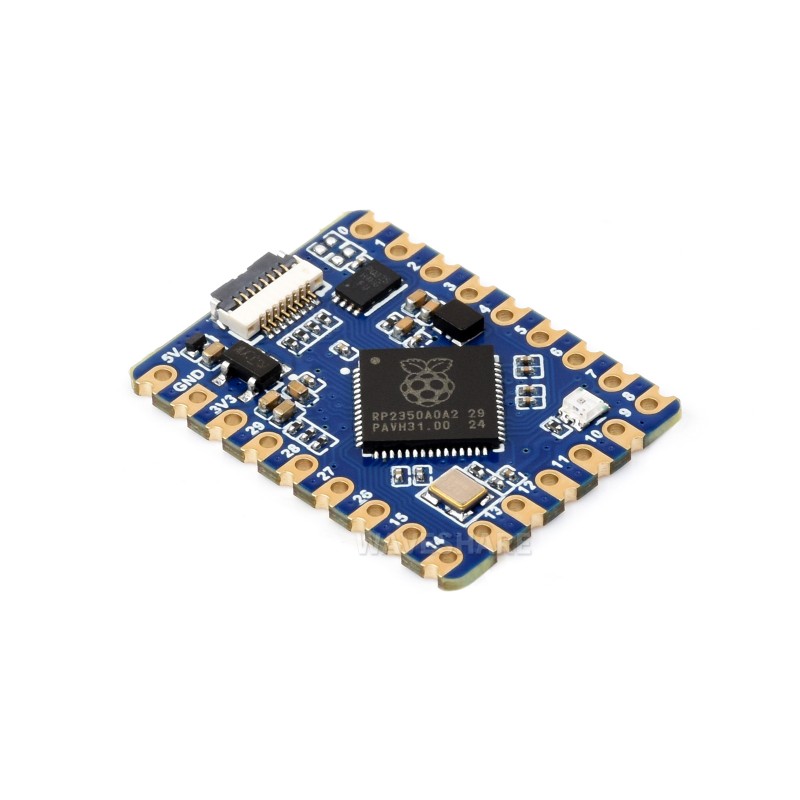






zł17.52 tax excl.
RP2350-Tiny is a minimalist development board based on the RP2350A microcontroller with dual Cortex-M33 and RISC-V architecture, without an integrated USB port. Instead, it features an FPC connector for attaching an external USB-C adapter (not included). The module offers extensive GPIO and peripheral functionality, drag-and-drop programming, support for C/C++ and MicroPython, and SMT mounting capability. It is ideal for embedded projects where minimal space and flexible connectivity are essential.
RP2350-Tiny is a compact development board from Waveshare based on the RP2350A microcontroller designed by Raspberry Pi. The chip features a dual architecture – two Arm Cortex-M33 cores and two Hazard 3 RISC-V cores – with a maximum clock speed of up to 150 MHz. The board includes 520 KB of SRAM and 4 MB of NOR Flash memory. Thanks to its castellated holes, the module can be directly surface-mounted onto a base board (SMD).
The board does not have an integrated USB connector – instead, it is equipped with an 8-pin 0.5 mm pitch FPC connector that allows for connection of an external USB Type-C adapter (adapter and FPC cable are included in the RP2350-Tiny-Kit, sold separately). It supports SPI, I2C, UART, ADC, PWM, and PIO interfaces, as well as low-power sleep modes and drag-and-drop USB programming (via the external adapter).
Data sheet
Manufacturer BTC Korporacja sp. z o. o. Lwowska 5 05-120 Legionowo Poland sprzedaz@kamami.pl 22 767 36 20
Responsible person BTC Korporacja sp. z o. o. Lwowska 5 05-120 Legionowo Poland sprzedaz@kamami.pl 22 767 36 20
The board with the RP2040 microcontroller in the form of a USB dongle. Equipped with Stemma QT connector, RGB NeoPixel diode, boot and reset button. Adafruit 5056
Base board with soldered Raspberry Pi Pico W module. Equipped with numerous connectors, buzzer, buttons and LEDs. Cytron MAKER-PI-PICO-MINI-W
NeoPixel 8-channel RGB LED driver. It features an RP2040 microcontroller with two ARM Cortex-M0+ cores, 264 kB of RAM and 8 MB of external Flash memory. Adafruit 5650
Module with a round 1.28" IPS LCD touch display with a resolution of 240x240 px and an RP2040 microcontroller. Equipped with an accelerometer and gyroscope. Enclosed in a nice metal housing. Waveshare RP2040-Touch-LCD-1.28-B
Mechanical keyboard module with LED backlight, encoder and display. Based on the RP2040 microcontroller. Adafruit 5100
No product available!
Base board with soldered Raspberry Pi Pico module. Equipped with numerous connectors, buzzer, buttons and LEDs. Cytron MAKER-PI-PICO-MINI
The board with the RP2040 microcontroller equipped with two ARM Cortex-M0+ cores. The board also has 4 MB of QSPI flash memory. 1.14" LCD module. TTGO T-Display RP2040
RP2350-LCD-1.47-B-M is an advanced yet compact development board designed to work with the RP2350A microcontroller. The integrated LCD display, USB Type-A port, TF card slot, and pre-soldered headers facilitate quick setup and easy integration into various projects. The dual architecture (ARM and RISC-V) provides great flexibility for learning and testing embedded applications, control systems, and IoT devices.
This modern development board features a dual-core Cortex-M33 microcontroller clocked at 150 MHz, 520 KB of RAM, and 8 MB of QSPI Flash. It features a rich set of interfaces, including I2C, SPI, UART, 24 PWM channels, and an HSTX port for high-speed differential data transfer. The board features a STEMMA QT connector, a built-in 200 mA+ LiPo charger, a USB-C port with a UF2 bootloader, and NeoPixel LEDs and a red LED for signaling. The Feather RP2350 is compatible with MicroPython, CircuitPython, Arduino, and C/C++. Adafruit 6000
RP2350-Touch-AMOLED-1.43-B is a compact development board with an AMOLED display and capacitive touch, enclosed in a robust CNC-machined case. Integrated sensors and interfaces offer extensive expansion and application possibilities in HMI projects, wearable electronics, and smart control systems. Support for C/C++, MicroPython, and Arduino IDE, along with rich SDK resources, facilitates rapid project deployment.
Development board based on the RP2040 microcontroller. It is equipped with a 1.14" color LCD display and a built-in debugging tool via USB interface. The board is enclosed in a plastic housing. Waveshare RP2040-GEEK
Module with a 2.9" ePaper display and a Raspberry Pi Pico W board equipped with WiFi communication. It has a built-in Qwiic/Stemma QT connector with an I2C interface, buttons and a battery connector. Perfect as a display for a weather station. Pimoroni PIM669
Module with the RP2040 microcontroller with two ARM Cortex-M0 + cores operating at 133 MHz, 256 kB RAM and 30 GPIO. The board also has 2 MB of external QSPI flash memory. Module can be programmed in C/C++ or microPython. Raspberry Pi Pico
RP2350-Touch-LCD-1.28-B is a compact development module with a color touch screen, ideal for projects requiring an HMI interface and mobile integration with sensors. Thanks to the CNC enclosure, the product gains durability and better heat dissipation, making it suitable for prototyping and embedded applications where reliability and elegant design are important. Support for multiple programming languages and extensive technical documentation facilitate rapid development of applications based on ARM and RISC-V architecture.
The board with the RP2040 microcontroller equipped with two ARM Cortex-M0 + cores, which work at a frequency of 133 MHz, 256 kB RAM. The board also has 16 MB of QSPI flash memory. The system can be programmed in C/C++ or microPython. SparkFun DEV-17745
The board with the RP2040 microcontroller equipped with two ARM Cortex-M0+ cores, which work at a frequency of 133 MHz, 264 kB RAM. The board also has 4 MB of QSPI flash memory. The system can be programmed in C/C++ or MicroPython. Waveshare RP2040-Plus

RP2350-Tiny is a minimalist development board based on the RP2350A microcontroller with dual Cortex-M33 and RISC-V architecture, without an integrated USB port. Instead, it features an FPC connector for attaching an external USB-C adapter (not included). The module offers extensive GPIO and peripheral functionality, drag-and-drop programming, support for C/C++ and MicroPython, and SMT mounting capability. It is ideal for embedded projects where minimal space and flexible connectivity are essential.
